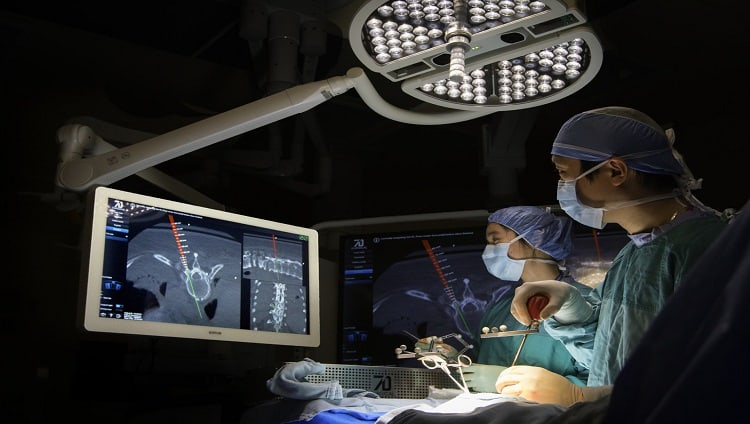More than 17.5 million electrosurgical procedures are performed annually in the United States, in a variety of surgical fields. Yet, electrosurgical methods have changed little in the last 80 years. They have remained relatively crude, essentially relying on high-temperature electrical arcs to cut and coagulate. As a result, electrosurgery affords a lack of precision with a high risk of unintentional injury to tissues and structures surrounding the surgical site.
As a result, electrosurgery affords a lack of precision with a high risk of unintentional injury to tissues and structures surrounding the surgical site. New advances, however, can cut tissue as precisely as a scalpel and control bleeding as effectively as traditional electrosurgery without causing extensive collateral thermal damage to surrounding tissues. PEAK Surgical’s PEAK® Surgery System, for example, uses pulsed electrical waveforms to generate a highly controlled electrical plasma for soft-tissue cutting and coagulation with minimal thermal injury.
History of Electrosurgery
Designed to control bleeding during surgery, electrosurgery was developed in the early 1900s by William T. Bovie.1 Neurosurgeon Harvey W. Cushing performed the first electrosurgical procedure with his instrument in 1926. Still in widespread use today, conventional electrosurgery uses continuous-waveform radiofrequency (RF) energy, delivered through an electrode, to make thermal “cuts” in tissue and minimize bleeding by simultaneously coagulating the surrounding tissue via thermal denaturation and charring.
However, the basic electro-thermal mechanism behind electrosurgery makes it less precise than a traditional surgical scalpel, and prone to causing collateral thermal damage to surrounding tissues and structures. Conventional electrosurgical devices create a wide ablation trough with a deep (300 – 1,000 mm) zone of thermal damage that has the potential to result in functional destruction of adjacent tissues, nerve structures and delicate vasculature. It also may increase wound scarification, delay healing and possibly increase infection rates as thermal eschar and debris may act as a harbinger for infection. Additionally, in cases where the degree of risk of collateral damage or scarring from electrosurgery is unacceptable, such as in delicate obstetrical/gynecological, cardiac/vascular surgeries or plastic/reconstructive surgeries, surgeons must use a traditional scalpel for cutting and an electrosurgery device for coagulation.
Attempts to address these limitations by insulating or coating the electrodes, altering the electrode shape and using high-frequency or blended frequency modes have met with little success. For example, laser surgery has improved on cutting precision, but can be slow and cumbersome and cause significant collateral tissue damage. The use of ultrasonic energy instead of electricity has shown a reduction in thermal injury to tissues and is efficient at large blood vessel coaptation (sealing), but the instruments are bulky, not suitable for precisely cutting skin, and have limited coagulation capability in their cutting blade model.
Recent Advances in Electrosurgery
In July 2008, the U.S. Food and Drug Administration cleared the PEAK Surgery System for soft tissue cutting and coagulation during general surgery. This system exploits the properties of electrical plasma, generated with pulsed RF waveforms, to provide the cutting precision of a traditional scalpel with simultaneous coagulation. It includes the PULSAR™ Generator, which supplies pulsed plasma radiofrequency energy, and the PEAK PlasmaBlade™ family of disposable surgical cutting and coagulation tools.
Electrical plasma is an electrically ionized gas consisting of positive ions and dissociated electrons with an overall neutral electrical charge. Intense energy is released when electrical plasma comes into contact with biological tissues at atmospheric pressure. When properly harnessed, that energy can be used in a surgical setting to precisely cut tissue and provide hemostasis.2
The pulsed nature of the plasma created by the PULSAR Generator and the high degree of insulation (99.5 percent versus 75 percent in coated conventional electrosurgical instruments) of the PlasmaBlade means that, for typical procedures, the instrument can be operated in a much lower range of duty cycles (“on time”) (less than 10 percent) than continuous-waveform (100 percent duty-cycle) electrosurgical devices. The PlasmaBlade, therefore, returns a much lower average power output than conventional electrosurgery and uses less total energy to achieve tissue cutting, which means that it remains significantly cooler during surgery and allows the tissue to cool between pulses.3 This limits the extent of thermal diffusion from the blade into the surrounding tissue approximately 10-fold when compared to conventional electrosurgery.
The PlasmaBlade can be used on all soft tissue types, including skin, fat and muscle. It operates equally well in wet and dry fields and is particularly useful in fields in which the amount of fluid changes during the procedure, such as in bloody fields or where edema or tumescence are present.
Potentially Improved Surgical Outcomes with the PlasmaBlade
The underlying technology of the PlasmaBlade gives it the combined advantages of a traditional surgical scalpel’s cutting precision and conventional electrosurgery’s coagulation capability, while minimizing collateral damage. These advantages may translate into improved surgical outcomes.
Reduction in unintentional tissue injury
The PlasmaBlade offers the potential for reducing the incidence of unintentional tissue injury because the pulsed electrical waveforms and highly insulated cutting electrode are specifically engineered to minimize collateral thermal damage. The PlasmaBlade’s ablation trough is more comparable to the incision made by a traditional scalpel than to conventional electrosurgery, and the thermal damage zone is typically reduced in depth by a factor of ten. These measures are significant in procedures such as abdominal or gynecological surgeries, in which the bowels, bladder and ureters are separated from the other abdominal and pelvic organs by very thin margins, and are common sites of unintentional surgical injury.
Cuts made with the PlasmaBlade can be achieved in a tractionless, pressureless, non-deforming manner, with significantly less tissue sticking than a traditional scalpel or electrosurgical tool. The surgeon does not have to put the tissue under tension in order to make cuts, allowing greater control over the depth of cutting and reducing the chances of slippage, tearing, unintentional extension of incisions4 and accidental cutting of adjacent tissues or organs.
Reduced bleeding, improved wound healing and reduced scarification
Surgeons who require the precision of a scalpel must have a method for controlling bleeding during surgery, both to minimize blood loss and to maintain adequate visualization of the field. The PlasmaBlade overcomes the scalpel’s chief disadvantage of lack of bleeding control. Unlike a scalpel, the PlasmaBlade has the coagulation capabilities of conventional electrosurgery,5 so that bleeding can be controlled without switching instruments.
A preclinical study in porcine skin showed that cuts made with the PlasmaBlade exhibited less post-operative swelling and erythema when compared to conventional electrosurgery.6 Fewer macrophages and myofibroblasts infiltrated the wound site following PlasmaBlade surgery, indicating a reduction in inflammation. These results suggest that surgeries with the PlasmaBlade may result in better wound healing and potentially less postoperative pain than with conventional electrosurgery.
In support of this hypothesis, the porcine skin study compared the acute thermal damage, six-week scar histology and burst strength of surgical incision wounds created with the PlasmaBlade, conventional electrosurgery and a traditional scalpel. The PlasmaBlade was found to be comparable to the scalpel, with a 75 percent reduction in acute thermal damage and 66 percent less scarring than the wounds created by conventional electrosurgery. The conventional electrosurgery wounds showed 61 percent less strength than wounds made by the PlasmaBlade or scalpel.7
The PlasmaBlade’s potential for reduced blood loss and improved wound healing and recovery may translate to shorter lengths of stay for patients, with significant resultant savings in hospital costs.
May reduce potential for surgical site infections
The PlasmaBlade could possibly reduce the incidence of surgical site infections (SSIs) as it causes less deposition of eschar because of the cooler temperatures at which it operates, and also leaves behind less necrotic tissue. Thus it reduces two potential harbors for infectious microorganisms, and lessens the burden on the inflammatory system as the body attempts to clear the dead material. The reduced chance of SSIs may lessen the likelihood that patients will return to the hospital after discharge for costly treatment of infections. In a retrospective study published in the Archives of Surgery, SSIs following breast surgery were found to have occurred in more than 5 percent of patients, with associated hospital costs of more than $4,000 per incident.8
Operating room efficiency and OR staff safety
The PlasmaBlade also enables greater surgical efficiency and enhanced safety for the OR staff. Fast, smooth cutting with integrated bleeding control can shorten the amount of time needed for a given procedure, as can the ease with which the PlasmaBlade can be wiped clean. The surgeon can cut with precision, coagulate and manipulate tissue directly with the PlasmaBlade, without concern that it will lose performance when the surgical field fills with blood, liquefied fat or other fluids. With all of these capabilities in one instrument, the surgeon can use the PlasmaBlade without repeatedly switching tools, improving workflow efficiency and reducing the chance for sharps injuries or burns encountered when switching between a scalpel blade and an electrosurgery device.
And, because the PlasmaBlade cuts tissue via a relatively low temperature mechanism, the system produces little to no surgical smoke relative to conventional electrosurgery. Surgical smoke is a potential carcinogen and potential vehicle for viral transmission because it contains aerosolized biological tissues.9
Conclusion
The PlasmaBlade represents an important advance in electrosurgery as it offers the cutting precision of a scalpel and the coagulation capabilities of conventional electrosurgery with minimal thermal injury. It may offer significant safety and economic benefits for patients, surgeons, hospitals and payers.
1 Bovie, Surg. Gynecol. Obst. 1928
2 Stalder et al Applied Physics Letters 2001; Stalder et al J. Physics D: Applied Physics 2005
3 Palanker et al IEEE Trans. Biomed. Eng. 2008; Vankov and Palanker J. Appl. Phys. 2007
4 Priglinger et al, Br. J. Ophthalmol 2007
5 Palanker et al, Bioelectromagnetics 2007
6 Loh et al, J Am Coll Surg 2007 (Suppl);207: S54
7 Loh et al, J Am Coll Surg 2007 (Suppl);207: S54
8 Olsen et al, Arch. Surg. 2008
9 Alp et al, J. Hosp. Infection 2006; Barrett Surg. Endosc. 2003; Bigony, AORN Journal 2007



















